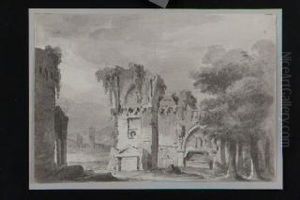Francesco Fontanesi Paintings
Francesco Fontanesi was an Italian painter known for his contributions to landscape painting, born in Reggio Emilia, Italy in 1804. His work was part of the Romantic movement that swept through Europe in the 19th century. Fontanesi's style was characterized by a keen observation of nature and a delicate use of color, which he employed to capture the ephemeral qualities of light and atmosphere.
Initially trained at the Accademia di Belle Arti in Modena, he later moved to Rome, which was a hub for artists at the time. In Rome, Fontanesi was exposed to the works of the great masters and began to develop his own artistic language, inspired by the Roman Campagna's landscapes. His early works show an affinity with the classical landscape tradition, but as his style matured, it became more personal and expressive.
Fontanesi's travels throughout Italy, and later to the Middle East and Asia Minor, broadened his horizons and influenced his approach to landscape painting. He spent a significant period in Istanbul, where he taught at the Imperial School of Engineering and had considerable influence on the development of modern art in Turkey.
Upon his return to Italy, Fontanesi continued to teach and inspire younger artists. He took a position at the Accademia Albertina in Turin, where he was appreciated not only for his artistic talents but also for his teaching abilities. Among his students were many who would go on to become significant artists in their own right.
Despite his success as a teacher, Fontanesi's own work often struggled to gain the recognition it deserved during his lifetime. His later years were marked by financial difficulties and a declining reputation. However, his landscapes continued to be characterized by a poetic and often moody quality, with a focus on the interplay between light and shadow.
Francesco Fontanesi passed away in 1867, leaving behind a body of work that would eventually be recognized for its importance in the evolution of landscape painting in Italy. Today, his paintings can be found in numerous art galleries and collections across the world, and his contribution to the art of the 19th century is well acknowledged by art historians and enthusiasts alike.
